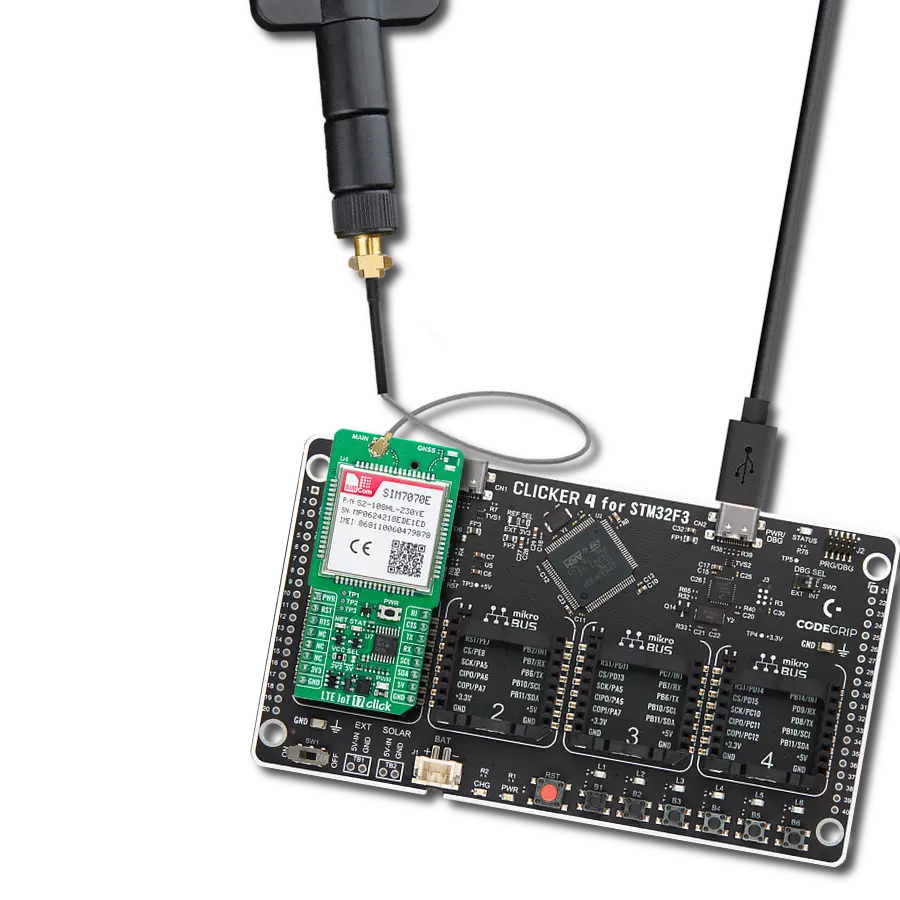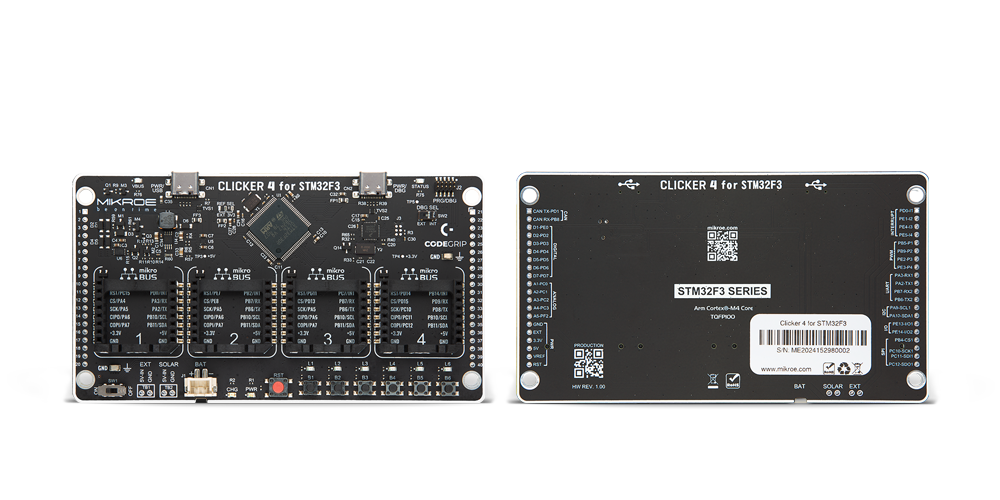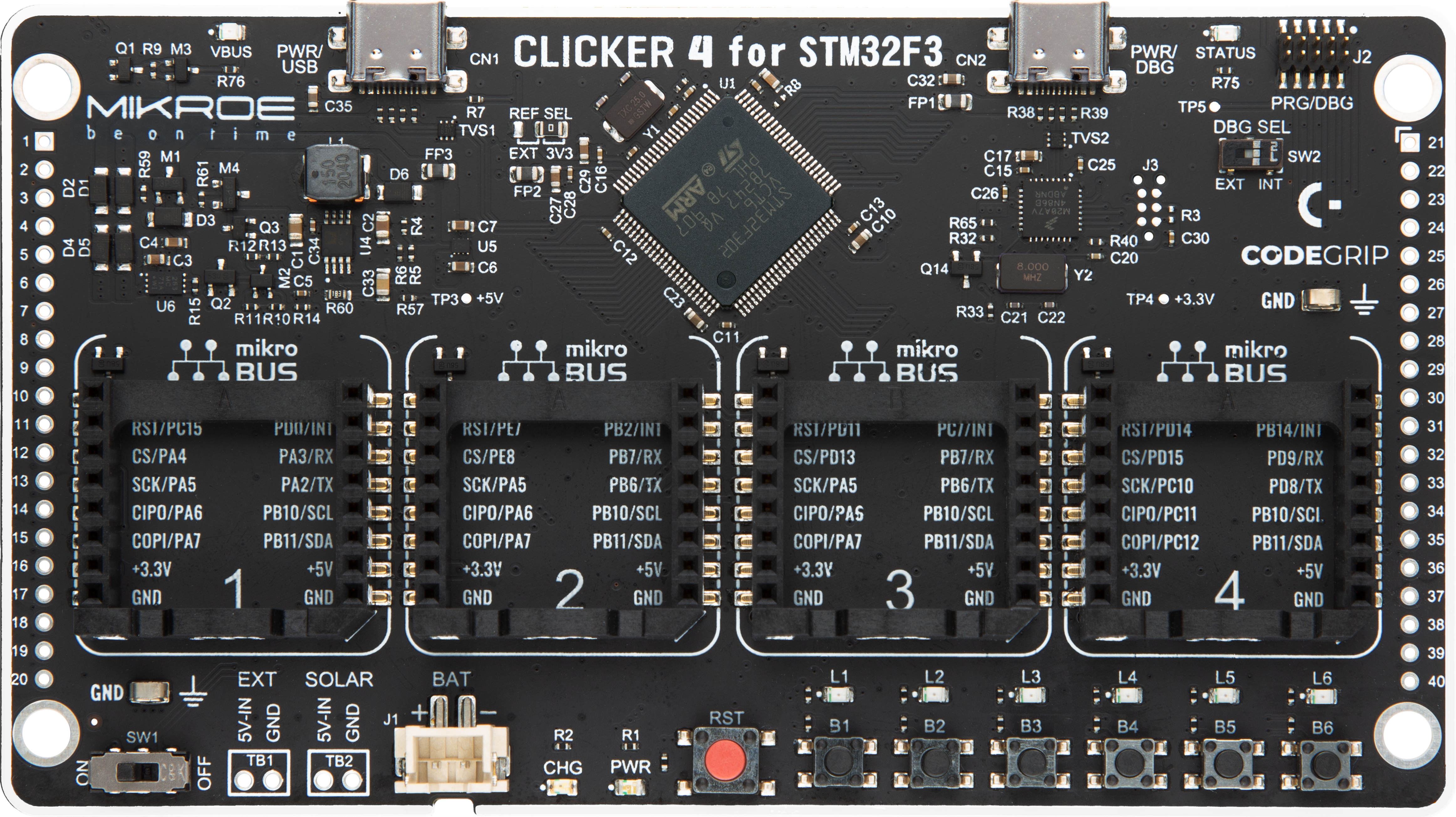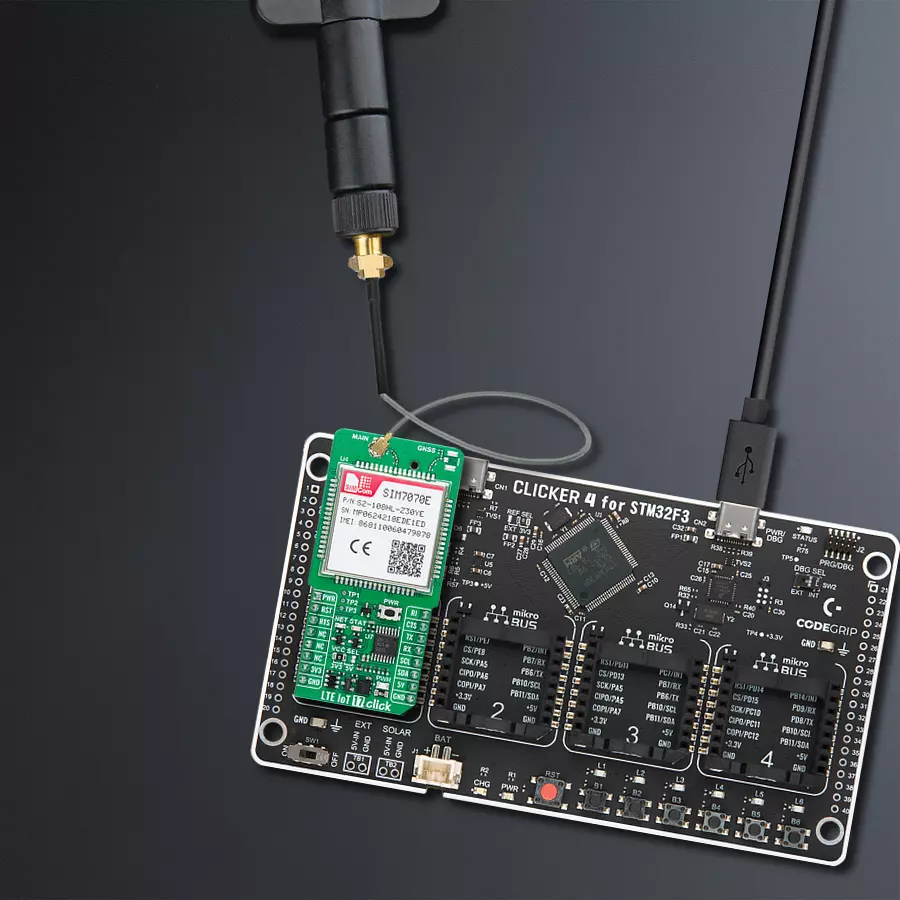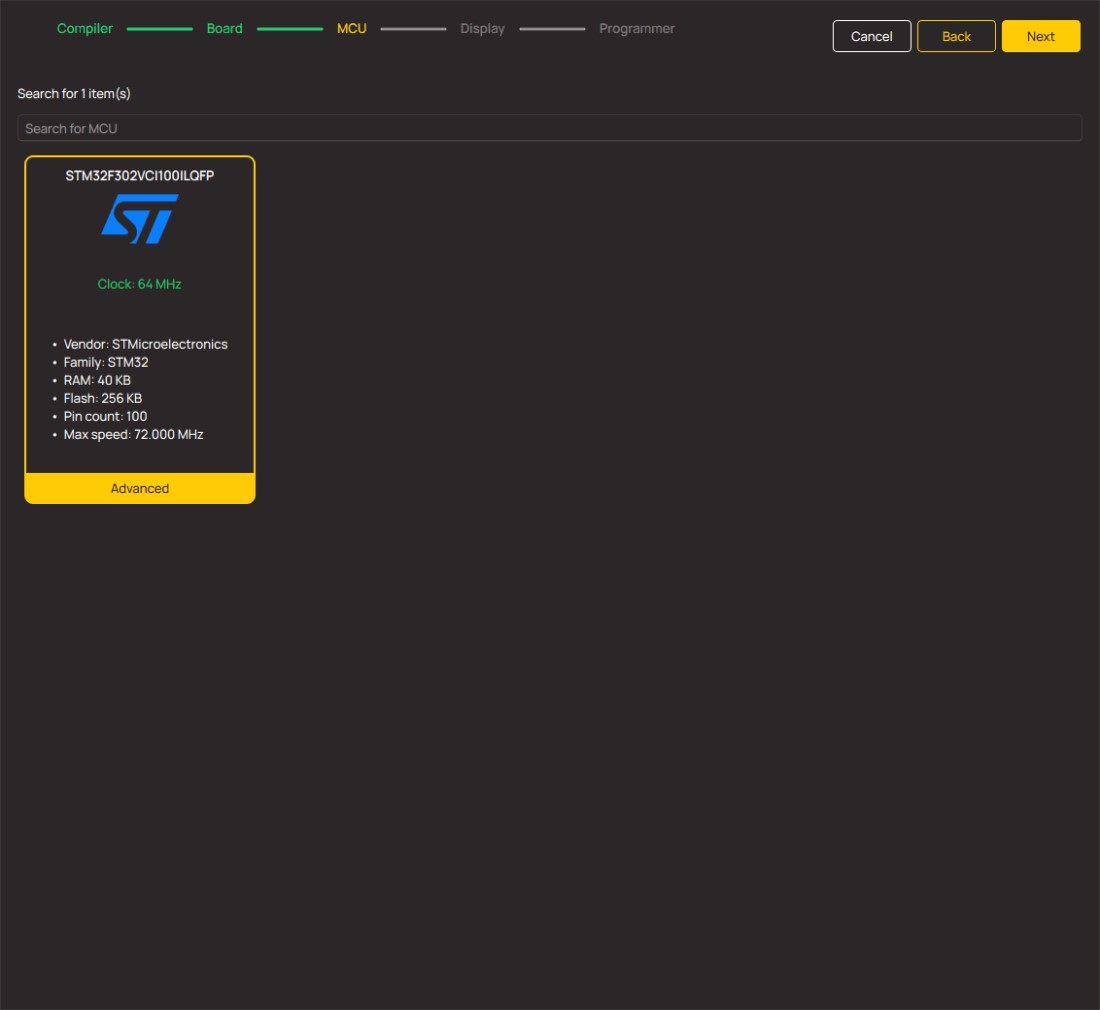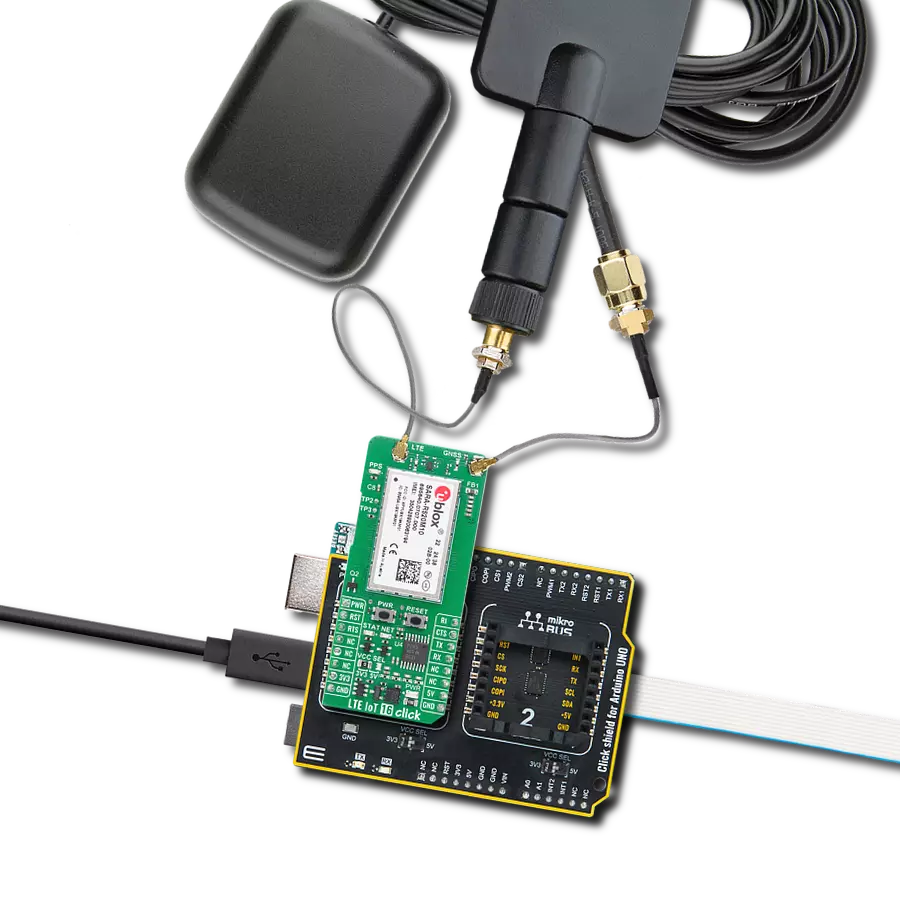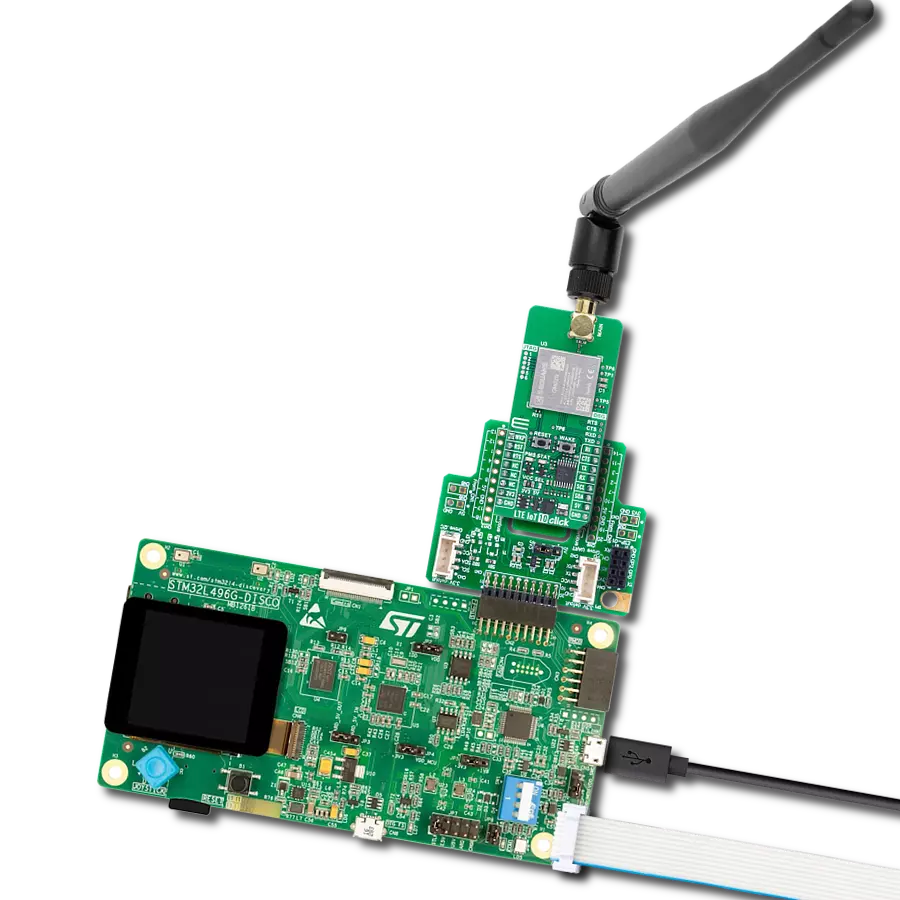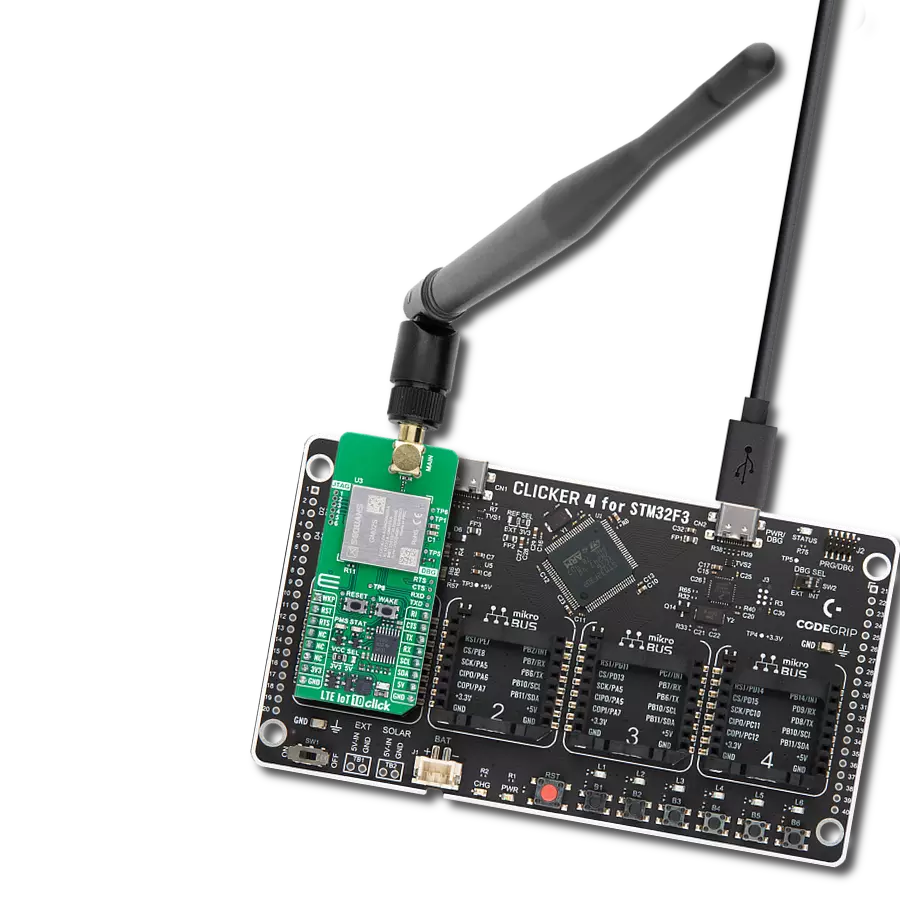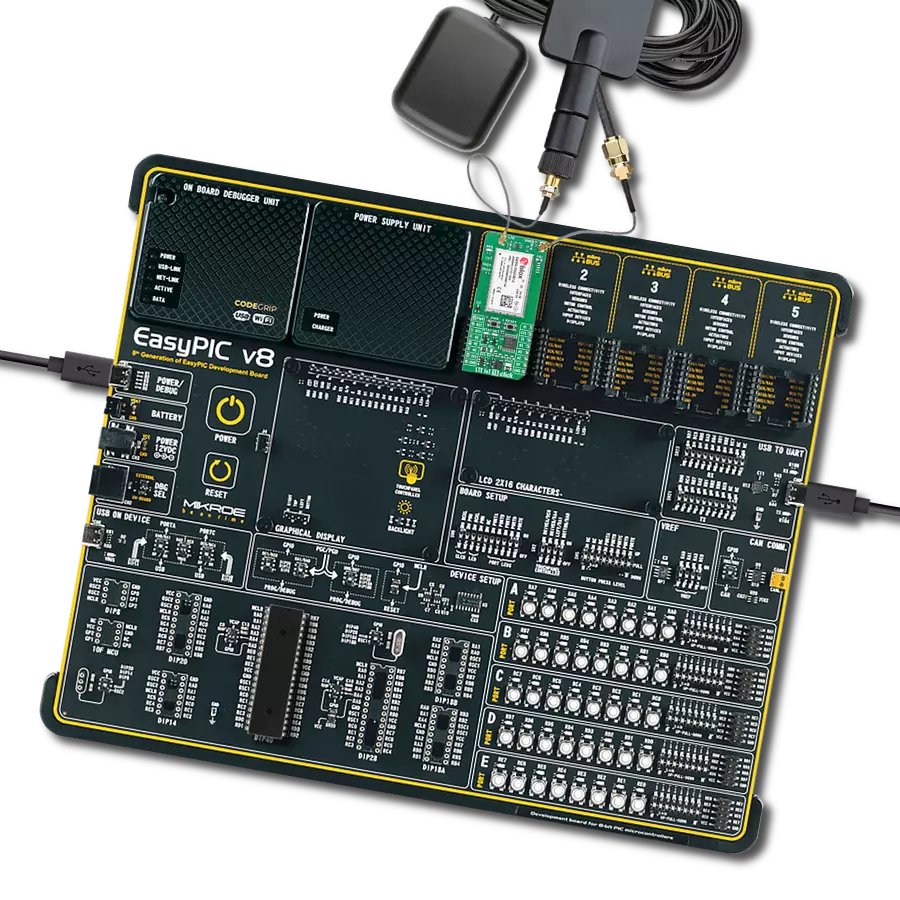低功耗、长距离蜂窝连接,支持多频段 LTE 和 GNSS,适用于资产追踪、计量和远程监控
A
A
硬件概览
它是如何工作的?
LTE IoT 17 Click基于SIMCom的多频段LTE模块SIM7070E,适用于欧洲和澳大利亚地区。SIM7070E支持Cat-M/Cat-NB/GPRS/EDGE无线通信模式,内置多个网络协议,最大下行速率为0.589Mbps,最大上行速率为1.119Mbps。此外,它还支持多个Cat-M频段(B1/B2/B3/B4/B5/B8/B12/B13/B14/B18/B19/B20/B
25/B26/B27/B28/B31/B66/B72/B85)、Cat-NB频段(B1/B2/B3/B4/B5/B8/B12/B13/B18/B19/B20/B25/
B26/B28/B31/B66/B85),以及850/900/1800/1900MHz的GSM频段,并提供可选的多星座GNSS支持。凭借其广泛的功能,此Click板™非常适合需要低延迟、低吞吐量数据通信的M2M应用,例如计量、资产追踪、远程监控、电子健康等。SIM7070E与主机MCU之间的通信通过UART接口实现,使用标准的UART RX和TX引脚以及硬件流控制引脚(CTS/RTS/RI - Clear to Send/Ready to Send/Ring Indicator),确保高效的数据传输。模块的默认通信速度为115200bps,支持通过AT命令进行无缝数据交换。该板还配备了模块家族支持的音频接口所需的所有组件和电路。然而,在当前版本中,板上的模块并不支持音频接口,因此这些组件未焊接至
板上。在音频接口的情况下,模块的音频接口通过I2C接口配置的NAU88C10单声道音频语音编解码器工作。这一配置与板背面的CTIA标准耳机插孔配合使用,CTIA耳机通常用于现代智能手机,集成了音频和麦克风连接器。这一标准确保了与广泛的耳机和耳麦兼容。此Click板™还包括一个USB Type C接口,既可用于电源供应也可用于数据传输,符合USB 2.0规范(仅限外围设备)。此外,板上还有一个USB固件升级开关,位于板背面,标为USB BOOT,用于管理固件升级。开关有两个位置:0表示正常操作,1表示通过USB进行固件升级,确保了简单的升级流程。LTE IoT 17 Click还包括几个增强其可用性和控制功能的附加功能。PWR按钮允许用户轻松打开或关闭模块电源。此功能还可通过PWR mikroBUS™引脚进行数字控制,提供更大的灵活性。此外,板上还设有专用测试点(TP1和TP2用于DBG_UART),便于调试和测试,并配备两个视觉指示灯,提供实时状态更新。第一个红色的NET LED指示模块的当前网络状态。当LED缓慢闪烁时(64ms亮,3000ms灭),表示设备已成功注册到网络的PS域。如果LED以正常速度闪烁(64ms亮,800ms灭),则表示设备尚未注册到网络。快速闪烁(64ms亮,300ms灭)表示数据传输正
在进行,例如PPP拨号连接或使用数据服务(如内部TCP、FTP或HTTP)时。当LED完全熄灭时,表示设备已关闭或处于省电模式(PSM)。第二个黄色STAT LED指示模块的电源状态,当模块关闭时,LED熄灭,当模块开启或固件准备就绪时,LED亮起。该板具有两个u.Fl连接器,用于主LTE和可选的GNSS天线,MIKROE提供了LTE扁平旋转天线和主动GPS天线,可与IPEX-SMA电缆结合,提供灵活且高效的连接选项。此外,用户还可以通过选择板背面的GNSS ANT跳线轻松选择可选GNSS天线的电源供应(3.3V或5V)。该板还具有一个micro SIM卡槽,仅支持1.8V的uSIM卡,允许用户选择最适合其特定使用场景的服务提供商。此Click板™可以在3.3V和5V逻辑电压水平下工作,通过VCC SEL跳线选择合适的电压。由于SIM7070E模块在3.8V下工作,因此还使用了逻辑电平转换器TXB0106和PCA9306,确保正常操作和准确的信号电平转换。这样,3.3V和5V的MCU都能正确使用通信线路。此外,此Click板™还附带了一个库,包含易于使用的功能和示例代码,可作为进一步开发的参考。
功能概述
开发板
Clicker 4 for STM32F3 是一款紧凑型开发板,作为完整的解决方案而设计,可帮助用户快速构建具备独特功能的定制设备。该板搭载 STMicroelectronics 的 STM32F302VCT6 微控制器,配备四个 mikroBUS™ 插槽用于连接 Click boards™、完善的电源管理功能以及其他实用资源,是快速开发各类应用的理想平台。其核心 MCU STM32F302VCT6 基于高性能
Arm® Cortex®-M4 32 位处理器,运行频率高达 168MHz,处理能力强大,能够满足各种高复杂度任务的需求,使 Clicker 4 能灵活适应多种应用场景。除了两个 1x20 引脚排针外,板载最显著的连接特性是四个增强型 mikroBUS™ 插槽,支持接入数量庞大的 Click boards™ 生态系统,该生态每日持续扩展。Clicker 4 各功能区域标识清晰,界面直观简洁,极大
提升使用便捷性和开发效率。Clicker 4 的价值不仅在于加速原型开发与应用构建阶段,更在于其作为独立完整方案可直接集成至实际项目中,无需额外硬件修改。四角各设有直径 4.2mm(0.165")的安装孔,便于通过螺丝轻松固定。对于多数应用,只需配套一个外壳,即可将 Clicker 4 开发板转化为完整、实用且外观精美的定制系统。
微控制器概述
MCU卡片 / MCU
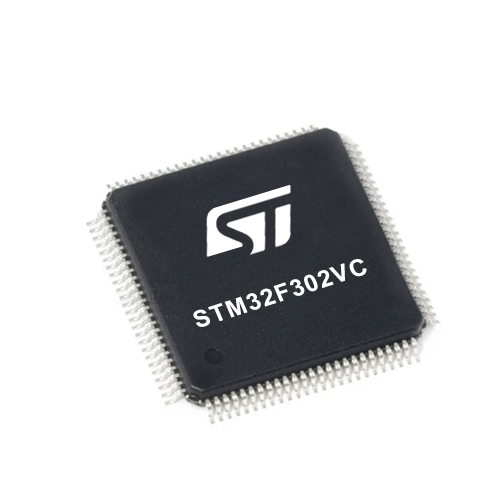
建筑
ARM Cortex-M4
MCU 内存 (KB)
256
硅供应商
STMicroelectronics
引脚数
100
RAM (字节)
40960
你完善了我!
配件
LTE Flat Rotation Antenna 是增强 3G/4G LTE 设备性能的多功能选择。凭借 700-2700MHz 的宽频率范围,它确保在全球主要蜂窝频段上的最佳连接。该平板天线采用 SMA 公头连接器,便于直接连接到设备或 SMA 模块连接器。其亮点之一是可调角度,可按 45⁰ 增量(0⁰/45⁰/90⁰)设置,允许您微调天线的方向以获得最佳信号接收。具有 50Ω 阻抗和 <2.0:1 的电压驻波比 (VSWR),此天线确保可靠高效的连接。其 5dB 增益、垂直极化和全向辐射图形增强了信号强度,适用于各种应用。天线长度为 196mm,宽度为 38mm,提供紧凑但有效的解决方案来改善您的连接。最大输入功率为 50W,能够满足各种设备的需求。

使用的MCU引脚
mikroBUS™映射器
“仔细看看!”
Click board™ 原理图

一步一步来
项目组装
实时跟踪您的结果
应用程序输出
1. 应用程序输出 - 在调试模式下,“应用程序输出”窗口支持实时数据监控,直接提供执行结果的可视化。请按照提供的教程正确配置环境,以确保数据正确显示。

2. UART 终端 - 使用UART Terminal通过USB to UART converter监视数据传输,实现Click board™与开发系统之间的直接通信。请根据项目需求配置波特率和其他串行设置,以确保正常运行。有关分步设置说明,请参考提供的教程。

3. Plot 输出 - Plot功能提供了一种强大的方式来可视化实时传感器数据,使趋势分析、调试和多个数据点的对比变得更加直观。要正确设置,请按照提供的教程,其中包含使用Plot功能显示Click board™读数的分步示例。在代码中使用Plot功能时,请使用以下函数:plot(insert_graph_name, variable_name);。这是一个通用格式,用户需要将“insert_graph_name”替换为实际图表名称,并将“variable_name”替换为要显示的参数。

软件支持
库描述
该库包含 LTE IoT Click 驱动程序的 API。
关键功能:
lteiot17_set_sim_apn- 此函数设置 SIM 卡的接入点名称(APN)。lteiot17_send_sms_text- 此函数向指定电话号码发送短信。lteiot17_send_cmd- 此函数向 Click 模块发送指定命令。
开源
代码示例
完整的应用程序代码和一个现成的项目可以通过NECTO Studio包管理器直接安装到NECTO Studio。 应用程序代码也可以在MIKROE的GitHub账户中找到。
/*!
* @file main.c
* @brief LTE IoT 17 Click Example.
*
* # Description
* Application example shows device capability of connecting to the network and
* sending SMS or TCP/UDP messages using standard "AT" commands.
*
* The demo application is composed of two sections :
*
* ## Application Init
* Initializes the driver and logger.
*
* ## Application Task
* Application task is split in few stages:
* - LTEIOT17_POWER_UP:
* Powers up the device, performs a device factory reset and reads system information.
*
* - LTEIOT17_CONFIG_CONNECTION:
* Sets configuration to device to be able to connect to the network.
*
* - LTEIOT17_CHECK_CONNECTION:
* Waits for the network registration indicated via CREG command and then checks the signal quality report.
*
* - LTEIOT17_CONFIG_EXAMPLE:
* Configures device for the selected example.
*
* - LTEIOT17_EXAMPLE:
* Depending on the selected demo example, it sends an SMS message (in PDU or TXT mode) or TCP/UDP message.
*
* By default, the TCP/UDP example is selected.
*
* ## Additional Function
* - static void lteiot17_clear_app_buf ( void )
* - static void lteiot17_log_app_buf ( void )
* - static err_t lteiot17_process ( lteiot17_t *ctx )
* - static err_t lteiot17_read_response ( lteiot17_t *ctx, uint8_t *rsp )
* - static err_t lteiot17_power_up ( lteiot17_t *ctx )
* - static err_t lteiot17_config_connection ( lteiot17_t *ctx )
* - static err_t lteiot17_check_connection ( lteiot17_t *ctx )
* - static err_t lteiot17_config_example ( lteiot17_t *ctx )
* - static err_t lteiot17_example ( lteiot17_t *ctx )
*
* @note
* In order for the examples to work, user needs to set the APN and SMSC (SMS PDU mode only)
* of entered SIM card as well as the phone number (SMS mode only) to which he wants to send an SMS.
* Enter valid values for the following macros: SIM_APN, SIM_SMSC and PHONE_NUMBER_TO_MESSAGE.
* Example:
SIM_APN "internet"
SIM_SMSC "+381610401"
PHONE_NUMBER_TO_MESSAGE "+381659999999"
*
* @author Stefan Filipovic
*
*/
#include "board.h"
#include "log.h"
#include "lteiot17.h"
#include "conversions.h"
// Example selection macros
#define EXAMPLE_TCP_UDP 0 // Example of sending messages to a TCP/UDP echo server
#define EXAMPLE_SMS 1 // Example of sending SMS to a phone number
#define DEMO_EXAMPLE EXAMPLE_TCP_UDP // Example selection macro
// SIM APN config
#define SIM_APN "internet" // Set valid SIM APN
// SMS example parameters
#define SIM_SMSC "" // Set valid SMS Service Center Address - only in SMS PDU mode
#define PHONE_NUMBER_TO_MESSAGE "" // Set Phone number to message
#define SMS_MODE "1" // SMS mode: "0" - PDU, "1" - TXT
// TCP/UDP example parameters
#define REMOTE_IP "77.46.162.162" // TCP/UDP echo server IP address
#define REMOTE_PORT "51111" // TCP/UDP echo server port
// Message content
#define MESSAGE_CONTENT "LTE IoT 17 Click board - demo example."
// Application buffer size
#define APP_BUFFER_SIZE 256
#define PROCESS_BUFFER_SIZE 256
/**
* @brief Example states.
* @details Predefined enum values for application example state.
*/
typedef enum
{
LTEIOT17_POWER_UP = 1,
LTEIOT17_CONFIG_CONNECTION,
LTEIOT17_CHECK_CONNECTION,
LTEIOT17_CONFIG_EXAMPLE,
LTEIOT17_EXAMPLE
} lteiot17_app_state_t;
/**
* @brief Application example variables.
* @details Variables used in application example.
*/
static uint8_t app_buf[ APP_BUFFER_SIZE ] = { 0 };
static int32_t app_buf_len = 0;
static lteiot17_app_state_t app_state = LTEIOT17_POWER_UP;
static lteiot17_t lteiot17;
static log_t logger;
/**
* @brief LTE IoT 17 clearing application buffer.
* @details This function clears memory of application buffer and reset its length.
* @note None.
*/
static void lteiot17_clear_app_buf ( void );
/**
* @brief LTE IoT 17 log application buffer.
* @details This function logs data from application buffer to USB UART.
* @note None.
*/
static void lteiot17_log_app_buf ( void );
/**
* @brief LTE IoT 17 data reading function.
* @details This function reads data from device and concatenates data to application buffer.
* @param[in] ctx : Click context object.
* See #lteiot17_t object definition for detailed explanation.
* @return @li @c 0 - Read some data.
* @li @c -1 - Nothing is read.
* See #err_t definition for detailed explanation.
* @note None.
*/
static err_t lteiot17_process ( lteiot17_t *ctx );
/**
* @brief LTE IoT 17 read response function.
* @details This function waits for a response message, reads and displays it on the USB UART.
* @param[in] ctx : Click context object.
* See #lteiot17_t object definition for detailed explanation.
* @param[in] rsp Expected response.
* @return @li @c 0 - OK response.
* @li @c -2 - Timeout error.
* @li @c -3 - Command error.
* @li @c -4 - Unknown error.
* See #err_t definition for detailed explanation.
* @note None.
*/
static err_t lteiot17_read_response ( lteiot17_t *ctx, uint8_t *rsp );
/**
* @brief LTE IoT 17 power up function.
* @details This function powers up the device, performs device factory reset and reads system information.
* @param[in] ctx : Click context object.
* See #lteiot17_t object definition for detailed explanation.
* @return @li @c 0 - OK.
* @li @c != 0 - Read response error.
* See #err_t definition for detailed explanation.
* @note None.
*/
static err_t lteiot17_power_up ( lteiot17_t *ctx );
/**
* @brief LTE IoT 17 config connection function.
* @details This function configures and enables connection to the specified network.
* @param[in] ctx : Click context object.
* See #lteiot17_t object definition for detailed explanation.
* @return @li @c 0 - OK.
* @li @c != 0 - Read response error.
* See #err_t definition for detailed explanation.
* @note None.
*/
static err_t lteiot17_config_connection ( lteiot17_t *ctx );
/**
* @brief LTE IoT 17 check connection function.
* @details This function checks the connection to network.
* @param[in] ctx : Click context object.
* See #lteiot17_t object definition for detailed explanation.
* @return @li @c 0 - OK.
* @li @c != 0 - Read response error.
* See #err_t definition for detailed explanation.
* @note None.
*/
static err_t lteiot17_check_connection ( lteiot17_t *ctx );
/**
* @brief LTE IoT 17 config example function.
* @details This function configures device for the selected example.
* @param[in] ctx : Click context object.
* See #lteiot17_t object definition for detailed explanation.
* @return @li @c 0 - OK.
* @li @c != 0 - Read response error.
* See #err_t definition for detailed explanation.
* @note None.
*/
static err_t lteiot17_config_example ( lteiot17_t *ctx );
/**
* @brief LTE IoT 17 example function.
* @details This function executes SMS or TCP/UDP example depending on the DEMO_EXAMPLE macro.
* @param[in] ctx : Click context object.
* See #lteiot17_t object definition for detailed explanation.
* @return @li @c 0 - OK.
* @li @c != 0 - Read response error.
* See #err_t definition for detailed explanation.
* @note None.
*/
static err_t lteiot17_example ( lteiot17_t *ctx );
void application_init ( void )
{
log_cfg_t log_cfg; /**< Logger config object. */
lteiot17_cfg_t lteiot17_cfg; /**< Click config object. */
/**
* Logger initialization.
* Default baud rate: 115200
* Default log level: LOG_LEVEL_DEBUG
* @note If USB_UART_RX and USB_UART_TX
* are defined as HAL_PIN_NC, you will
* need to define them manually for log to work.
* See @b LOG_MAP_USB_UART macro definition for detailed explanation.
*/
LOG_MAP_USB_UART( log_cfg );
log_init( &logger, &log_cfg );
log_info( &logger, " Application Init " );
// Click initialization.
lteiot17_cfg_setup( <eiot17_cfg );
LTEIOT17_MAP_MIKROBUS( lteiot17_cfg, MIKROBUS_1 );
if ( UART_ERROR == lteiot17_init( <eiot17, <eiot17_cfg ) )
{
log_error( &logger, " Communication init." );
for ( ; ; );
}
log_info( &logger, " Application Task " );
app_state = LTEIOT17_POWER_UP;
log_printf( &logger, ">>> APP STATE - POWER UP <<<\r\n\n" );
}
void application_task ( void )
{
switch ( app_state )
{
case LTEIOT17_POWER_UP:
{
if ( LTEIOT17_OK == lteiot17_power_up( <eiot17 ) )
{
app_state = LTEIOT17_CONFIG_CONNECTION;
log_printf( &logger, ">>> APP STATE - CONFIG CONNECTION <<<\r\n\n" );
}
break;
}
case LTEIOT17_CONFIG_CONNECTION:
{
if ( LTEIOT17_OK == lteiot17_config_connection( <eiot17 ) )
{
app_state = LTEIOT17_CHECK_CONNECTION;
log_printf( &logger, ">>> APP STATE - CHECK CONNECTION <<<\r\n\n" );
}
break;
}
case LTEIOT17_CHECK_CONNECTION:
{
if ( LTEIOT17_OK == lteiot17_check_connection( <eiot17 ) )
{
app_state = LTEIOT17_CONFIG_EXAMPLE;
log_printf( &logger, ">>> APP STATE - CONFIG EXAMPLE <<<\r\n\n" );
}
break;
}
case LTEIOT17_CONFIG_EXAMPLE:
{
if ( LTEIOT17_OK == lteiot17_config_example( <eiot17 ) )
{
app_state = LTEIOT17_EXAMPLE;
log_printf( &logger, ">>> APP STATE - EXAMPLE <<<\r\n\n" );
}
break;
}
case LTEIOT17_EXAMPLE:
{
lteiot17_example( <eiot17 );
break;
}
default:
{
log_error( &logger, " APP STATE." );
break;
}
}
}
int main ( void )
{
/* Do not remove this line or clock might not be set correctly. */
#ifdef PREINIT_SUPPORTED
preinit();
#endif
application_init( );
for ( ; ; )
{
application_task( );
}
return 0;
}
static void lteiot17_clear_app_buf ( void )
{
memset( app_buf, 0, app_buf_len );
app_buf_len = 0;
}
static void lteiot17_log_app_buf ( void )
{
for ( int32_t buf_cnt = 0; buf_cnt < app_buf_len; buf_cnt++ )
{
log_printf( &logger, "%c", app_buf[ buf_cnt ] );
}
}
static err_t lteiot17_process ( lteiot17_t *ctx )
{
uint8_t rx_buf[ PROCESS_BUFFER_SIZE ] = { 0 };
int32_t overflow_bytes = 0;
int32_t rx_cnt = 0;
int32_t rx_size = lteiot17_generic_read( ctx, rx_buf, PROCESS_BUFFER_SIZE );
if ( ( rx_size > 0 ) && ( rx_size <= APP_BUFFER_SIZE ) )
{
if ( ( app_buf_len + rx_size ) > APP_BUFFER_SIZE )
{
overflow_bytes = ( app_buf_len + rx_size ) - APP_BUFFER_SIZE;
app_buf_len = APP_BUFFER_SIZE - rx_size;
memmove ( app_buf, &app_buf[ overflow_bytes ], app_buf_len );
memset ( &app_buf[ app_buf_len ], 0, overflow_bytes );
}
for ( rx_cnt = 0; rx_cnt < rx_size; rx_cnt++ )
{
if ( rx_buf[ rx_cnt ] )
{
app_buf[ app_buf_len++ ] = rx_buf[ rx_cnt ];
}
}
return LTEIOT17_OK;
}
return LTEIOT17_ERROR;
}
static err_t lteiot17_read_response ( lteiot17_t *ctx, uint8_t *rsp )
{
#define READ_RESPONSE_TIMEOUT_MS 120000
uint32_t timeout_cnt = 0;
lteiot17_clear_app_buf ( );
lteiot17_process( ctx );
while ( ( 0 == strstr( app_buf, rsp ) ) &&
( 0 == strstr( app_buf, LTEIOT17_RSP_ERROR ) ) )
{
lteiot17_process( ctx );
if ( timeout_cnt++ > READ_RESPONSE_TIMEOUT_MS )
{
lteiot17_clear_app_buf( );
log_error( &logger, " Timeout!" );
return LTEIOT17_ERROR_TIMEOUT;
}
Delay_ms( 1 );
}
Delay_ms ( 200 );
lteiot17_process( ctx );
if ( strstr( app_buf, rsp ) )
{
lteiot17_log_app_buf( );
log_printf( &logger, "--------------------------------\r\n" );
return LTEIOT17_OK;
}
else if ( strstr( app_buf, LTEIOT17_RSP_ERROR ) )
{
log_error( &logger, " CMD!" );
return LTEIOT17_ERROR_CMD;
}
log_error( &logger, " Unknown!" );
return LTEIOT17_ERROR_UNKNOWN;
}
static err_t lteiot17_power_up ( lteiot17_t *ctx )
{
err_t error_flag = LTEIOT17_OK;
uint8_t power_state = LTEIOT17_POWER_STATE_OFF;
for ( ; ; )
{
lteiot17_process( ctx );
lteiot17_clear_app_buf ( );
// Wake up UART interface
lteiot17_send_cmd( ctx, LTEIOT17_CMD_AT );
Delay_ms ( 500 );
log_printf( &logger, ">>> Check communication.\r\n" );
lteiot17_send_cmd( ctx, LTEIOT17_CMD_AT );
if ( ( ( LTEIOT17_OK == lteiot17_process( ctx ) ) && strstr( app_buf, LTEIOT17_RSP_OK ) ) )
{
power_state = LTEIOT17_POWER_STATE_ON;
break;
}
else if ( LTEIOT17_POWER_STATE_OFF == power_state )
{
power_state = LTEIOT17_POWER_STATE_ON;
log_printf( &logger, ">>> Power up device.\r\n" );
lteiot17_set_power_state ( ctx, LTEIOT17_POWER_STATE_ON );
}
else if ( LTEIOT17_POWER_STATE_ON == power_state )
{
power_state = LTEIOT17_POWER_STATE_OFF;
log_printf( &logger, ">>> Power down device.\r\n" );
lteiot17_set_power_state ( ctx, LTEIOT17_POWER_STATE_OFF );
}
}
lteiot17_send_cmd( ctx, LTEIOT17_CMD_AT );
error_flag |= lteiot17_read_response( ctx, LTEIOT17_RSP_OK );
log_printf( &logger, ">>> Get device model ID.\r\n" );
lteiot17_send_cmd( ctx, LTEIOT17_CMD_GET_MODEL_ID );
error_flag |= lteiot17_read_response( ctx, LTEIOT17_RSP_OK );
log_printf( &logger, ">>> Get device software version ID.\r\n" );
lteiot17_send_cmd( ctx, LTEIOT17_CMD_GET_SW_VERSION );
error_flag |= lteiot17_read_response( ctx, LTEIOT17_RSP_OK );
log_printf( &logger, ">>> Get device serial number.\r\n" );
lteiot17_send_cmd( ctx, LTEIOT17_CMD_GET_SERIAL_NUM );
error_flag |= lteiot17_read_response( ctx, LTEIOT17_RSP_OK );
return error_flag;
}
static err_t lteiot17_config_connection ( lteiot17_t *ctx )
{
err_t error_flag = LTEIOT17_OK;
#if ( ( DEMO_EXAMPLE == EXAMPLE_TCP_UDP ) || ( DEMO_EXAMPLE == EXAMPLE_SMS ) )
log_printf( &logger, ">>> Deregister from network.\r\n" );
#define DEREGISTER_FROM_NETWORK "2"
lteiot17_send_cmd_par( ctx, LTEIOT17_CMD_OPERATOR_SELECTION, DEREGISTER_FROM_NETWORK );
error_flag |= lteiot17_read_response( ctx, LTEIOT17_RSP_OK );
log_printf( &logger, ">>> Set SIM APN.\r\n" );
lteiot17_set_sim_apn( <eiot17, SIM_APN );
error_flag |= lteiot17_read_response( ctx, LTEIOT17_RSP_OK );
log_printf( &logger, ">>> Enable full functionality.\r\n" );
#define FULL_FUNCTIONALITY "1"
lteiot17_send_cmd_par( ctx, LTEIOT17_CMD_SET_PHONE_FUNCTIONALITY, FULL_FUNCTIONALITY );
error_flag |= lteiot17_read_response( ctx, LTEIOT17_RSP_OK );
log_printf( &logger, ">>> Enable network registration.\r\n" );
#define ENABLE_REG "2"
lteiot17_send_cmd_par( ctx, LTEIOT17_CMD_NETWORK_REGISTRATION, ENABLE_REG );
error_flag |= lteiot17_read_response( ctx, LTEIOT17_RSP_OK );
log_printf( &logger, ">>> Set automatic registration.\r\n" );
#define AUTOMATIC_REGISTRATION "0"
lteiot17_send_cmd_par( ctx, LTEIOT17_CMD_OPERATOR_SELECTION, AUTOMATIC_REGISTRATION );
error_flag |= lteiot17_read_response( ctx, LTEIOT17_RSP_OK );
#endif
return error_flag;
}
static err_t lteiot17_check_connection ( lteiot17_t *ctx )
{
err_t error_flag = LTEIOT17_OK;
#if ( ( DEMO_EXAMPLE == EXAMPLE_TCP_UDP ) || ( DEMO_EXAMPLE == EXAMPLE_SMS ) )
log_printf( &logger, ">>> Check network registration.\r\n" );
#define CONNECTED "+CREG: 2,1"
lteiot17_send_cmd_check ( <eiot17, LTEIOT17_CMD_NETWORK_REGISTRATION );
error_flag |= lteiot17_read_response( ctx, LTEIOT17_RSP_OK );
if ( strstr( app_buf, CONNECTED ) )
{
Delay_ms ( 1000 );
log_printf( &logger, ">>> Check signal quality.\r\n" );
lteiot17_send_cmd( <eiot17, LTEIOT17_CMD_SIGNAL_QUALITY_REPORT );
error_flag |= lteiot17_read_response( ctx, LTEIOT17_RSP_OK );
}
else
{
error_flag = LTEIOT17_ERROR;
Delay_ms ( 1000 );
Delay_ms ( 1000 );
}
#endif
return error_flag;
}
static err_t lteiot17_config_example ( lteiot17_t *ctx )
{
err_t error_flag = LTEIOT17_OK;
#if ( DEMO_EXAMPLE == EXAMPLE_TCP_UDP )
log_printf( &logger, ">>> Config APP network.\r\n" );
#define CONFIG_APP_NETWORK "1,1"
lteiot17_send_cmd_par( <eiot17, LTEIOT17_CMD_APP_NETWORK_CONFIG, CONFIG_APP_NETWORK );
error_flag |= lteiot17_read_response( ctx, LTEIOT17_RSP_OK );
log_printf( &logger, ">>> Activate APP network.\r\n" );
#define ACTIVATE_APP_NETWORK "1,1"
lteiot17_send_cmd_par( <eiot17, LTEIOT17_CMD_APP_NETWORK_ACTIVE, ACTIVATE_APP_NETWORK );
error_flag |= lteiot17_read_response( ctx, LTEIOT17_RSP_OK );
if ( strstr ( app_buf, "DEACTIVE" ) )
{
error_flag |= LTEIOT17_ERROR;
}
#elif ( DEMO_EXAMPLE == EXAMPLE_SMS )
log_printf( &logger, ">>> Select SMS format.\r\n" );
lteiot17_send_cmd_par( <eiot17, LTEIOT17_CMD_SELECT_SMS_FORMAT, SMS_MODE );
error_flag |= lteiot17_read_response( ctx, LTEIOT17_RSP_OK );
#endif
return error_flag;
}
static err_t lteiot17_example ( lteiot17_t *ctx )
{
err_t error_flag = LTEIOT17_OK;
#if ( DEMO_EXAMPLE == EXAMPLE_TCP_UDP )
uint8_t cmd_buf[ 100 ] = { 0 };
log_printf( &logger, ">>> Set TCP ID.\r\n" );
#define TCP_CID "1"
lteiot17_send_cmd_par ( <eiot17, LTEIOT17_CMD_SET_TCP_UDP_ID, TCP_CID );
error_flag |= lteiot17_read_response( ctx, LTEIOT17_RSP_OK );
log_printf( &logger, ">>> Open TCP connection.\r\n" );
#define PDP_CID "1"
#define TCP_CONN_TYPE "TCP"
strcpy( cmd_buf, TCP_CID );
strcat( cmd_buf, "," );
strcat( cmd_buf, PDP_CID );
strcat( cmd_buf, ",\"" );
strcat( cmd_buf, TCP_CONN_TYPE );
strcat( cmd_buf, "\",\"" );
strcat( cmd_buf, REMOTE_IP );
strcat( cmd_buf, "\"," );
strcat( cmd_buf, REMOTE_PORT );
lteiot17_send_cmd_par ( <eiot17, LTEIOT17_CMD_OPEN_TCP_UDP_CONNECTION, cmd_buf );
error_flag |= lteiot17_read_response( ctx, LTEIOT17_URC_CONNECTION_OPEN );
log_printf( &logger, ">>> Set UDP ID.\r\n" );
#define UDP_CID "2"
lteiot17_send_cmd_par ( <eiot17, LTEIOT17_CMD_SET_TCP_UDP_ID, UDP_CID );
error_flag |= lteiot17_read_response( ctx, LTEIOT17_RSP_OK );
log_printf( &logger, ">>> Open UDP connection.\r\n" );
#define UDP_CONN_TYPE "UDP"
strcpy( cmd_buf, UDP_CID );
strcat( cmd_buf, "," );
strcat( cmd_buf, PDP_CID );
strcat( cmd_buf, ",\"" );
strcat( cmd_buf, UDP_CONN_TYPE );
strcat( cmd_buf, "\",\"" );
strcat( cmd_buf, REMOTE_IP );
strcat( cmd_buf, "\"," );
strcat( cmd_buf, REMOTE_PORT );
lteiot17_send_cmd_par ( <eiot17, LTEIOT17_CMD_OPEN_TCP_UDP_CONNECTION, cmd_buf );
error_flag |= lteiot17_read_response( ctx, LTEIOT17_URC_CONNECTION_OPEN );
// Get message length
uint8_t message_len_buf[ 10 ] = { 0 };
uint16_t message_len = strlen( MESSAGE_CONTENT );
uint16_to_str( message_len, message_len_buf );
l_trim( message_len_buf );
r_trim( message_len_buf );
log_printf( &logger, ">>> Write message to TCP connection.\r\n" );
strcpy( cmd_buf, TCP_CID );
strcat( cmd_buf, "," );
strcat( cmd_buf, message_len_buf );
lteiot17_send_cmd_par ( <eiot17, LTEIOT17_CMD_SEND_DATA_VIA_CONNECTION, cmd_buf );
Delay_ms ( 200 );
lteiot17_generic_write ( <eiot17, MESSAGE_CONTENT, message_len );
error_flag |= lteiot17_read_response( ctx, LTEIOT17_URC_RECEIVED_DATA );
log_printf( &logger, ">>> Read response from TCP connection.\r\n" );
lteiot17_send_cmd_par( <eiot17, LTEIOT17_CMD_RECEIVE_DATA_VIA_CONNECTION, cmd_buf );
error_flag |= lteiot17_read_response( ctx, LTEIOT17_RSP_OK );
log_printf( &logger, ">>> Write message to UDP connection.\r\n" );
strcpy( cmd_buf, UDP_CID );
strcat( cmd_buf, "," );
strcat( cmd_buf, message_len_buf );
lteiot17_send_cmd_par ( <eiot17, LTEIOT17_CMD_SEND_DATA_VIA_CONNECTION, cmd_buf );
Delay_ms ( 200 );
lteiot17_generic_write ( <eiot17, MESSAGE_CONTENT, message_len );
error_flag |= lteiot17_read_response( ctx, LTEIOT17_URC_RECEIVED_DATA );
log_printf( &logger, ">>> Read response from UDP connection.\r\n" );
lteiot17_send_cmd_par( <eiot17, LTEIOT17_CMD_RECEIVE_DATA_VIA_CONNECTION, cmd_buf );
error_flag |= lteiot17_read_response( ctx, LTEIOT17_RSP_OK );
log_printf( &logger, ">>> Close TCP connection.\r\n" );
lteiot17_send_cmd_par ( <eiot17, LTEIOT17_CMD_CLOSE_TCP_UDP_CONNECTION, TCP_CID );
error_flag |= lteiot17_read_response( ctx, LTEIOT17_RSP_OK );
log_printf( &logger, ">>> Close UDP connection.\r\n" );
lteiot17_send_cmd_par ( <eiot17, LTEIOT17_CMD_CLOSE_TCP_UDP_CONNECTION, UDP_CID );
error_flag |= lteiot17_read_response( ctx, LTEIOT17_RSP_OK );
Delay_ms ( 1000 );
Delay_ms ( 1000 );
Delay_ms ( 1000 );
Delay_ms ( 1000 );
Delay_ms ( 1000 );
#elif ( DEMO_EXAMPLE == EXAMPLE_SMS )
// Check SMS mode
#define CMGF_PDU "+CMGF: 0"
#define CMGF_TXT "+CMGF: 1"
log_printf( &logger, ">>> Check SMS format.\r\n" );
lteiot17_send_cmd_check( <eiot17, LTEIOT17_CMD_SELECT_SMS_FORMAT );
error_flag |= lteiot17_read_response( ctx, LTEIOT17_RSP_OK );
if ( strstr( app_buf, CMGF_PDU ) )
{
// Send SMS in PDU mode
log_printf( &logger, ">>> Send SMS in PDU mode.\r\n" );
lteiot17_send_sms_pdu( <eiot17, SIM_SMSC, PHONE_NUMBER_TO_MESSAGE, MESSAGE_CONTENT );
error_flag |= lteiot17_read_response( ctx, LTEIOT17_RSP_OK );
}
else if ( strstr( app_buf, CMGF_TXT ) )
{
// Send SMS in TXT mode
log_printf( &logger, ">>> Send SMS in TXT mode.\r\n" );
lteiot17_send_sms_text ( <eiot17, PHONE_NUMBER_TO_MESSAGE, MESSAGE_CONTENT );
error_flag |= lteiot17_read_response( ctx, LTEIOT17_RSP_OK );
}
// 30 seconds delay
for ( uint8_t delay_cnt = 0; delay_cnt < 30; delay_cnt++ )
{
Delay_ms ( 1000 );
}
#else
#error "No demo example selected"
#endif
return error_flag;
}
// ------------------------------------------------------------------------ END
额外支持
资源
类别:LTE 物联网
